Family name: Solanaceae Jussieu
Synonym(s): Atropaceae Martinov; Cestraceae Schltdl.; Duckeodendraceae Kuhlm.; Goetzeaceae Miers ex Airy Shaw; Nolanaceae Bercht. & J. Presl, nom. cons.; Salpiglossidaceae Hutch.; Sclerophylacaceae Miers
Common name(s): potato family
*Number of genera/species: 97/2,600
List of genera records in GRIN-Global
Fruit dehiscentdehiscent:
(v. dehisce) splitting open at maturity to release contents (of a fruit)
 capsulecapsule:
capsulecapsule:
a dry, dehiscent fruit formed by two or more carpels
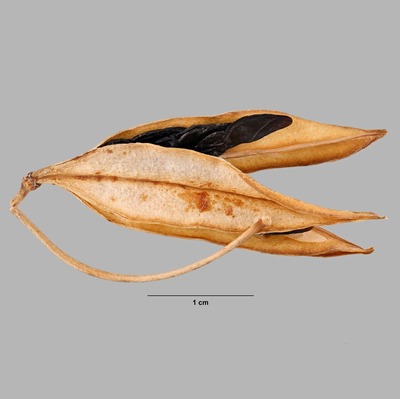 (loculicidal, septicidalsepticidal:
(loculicidal, septicidalsepticidal:
type of capsular dehiscence, opening longitudinally by separating between the septa of adjacent carpels
 , or septifragalseptifragal:
, or septifragalseptifragal:
type of capsular dehiscence, splitting through the exterior wall suture(s) but not the septum(-a), the valves of the wall then separating from the septum(-a) and the locules thus opened directly to the outside
, rarely circumscissle (Hyoscyamus)) or indehiscentindehiscent:
not opening on its own, as in a fruit
 berryberry:
berryberry:
an indehiscent, fleshy fruit with one or a few to many seeds. The flesh may be homogenous throughout. Or, if the outer part is hard, firm, or leathery, referred to as an hesperidium. Septa are present in some, and the seeds may be arillate or with a fleshy testa. , drupedrupe:
, drupedrupe:
(indehiscent drupe) a fleshy, indehiscent fruit with one more hard pits enclosing seeds; (dehiscent drupe) a fruit with a dry or fibrous to fleshy or leathery outer husk that early to tardily breaks apart (or opens), exposing one or more nutlike pits enclosing the seeds
 (Coeloneurum, Duckeodendron, Espadaea, Goetzea, Henoonia), schizocarpschizocarp:
(Coeloneurum, Duckeodendron, Espadaea, Goetzea, Henoonia), schizocarpschizocarp:
fruit formed from a single ovary, with fused carpels, with or without accessory tissue; splitting between locules to form distinct, indehiscent, usually one seeded segments; usually dry, rarely fleshy (compare mericarp)
 (Nolana), or carceruluscarcerulus:
(Nolana), or carceruluscarcerulus:
simple, multicarpellate, indehiscent fruit consisting of one or more seeds and air space enclosed by an undifferentiated pericarp (Spjut 1994)
(Sclerophylax), 3.5–100 mm long, globoseglobose:
3D shape—more or less spherical to angularangular:
to angularangular:
2D shape—having sides that meet at acute or obtuse angles
, tereteterete:
approximately circular in cross section; width and thickness approximately equal
 in transectiontransection:
in transectiontransection:
a cross section; representing a plane made by cutting across an organ at a right angle to its length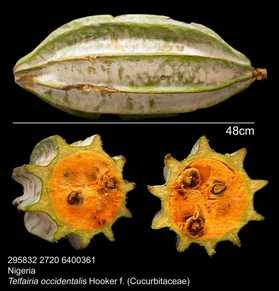 , 1- to many-seeded, usually subtended by persistent calyxcalyx:
, 1- to many-seeded, usually subtended by persistent calyxcalyx:
the outer whorl of the perianth; all the sepals of a flower
 , sometimes enclosed partially to fully by accrescentaccrescent:
, sometimes enclosed partially to fully by accrescentaccrescent:
growing continuously
calyx (sometimes inflated) or enclosed by hardened and spine-tipped calyxcalyx:
the outer whorl of the perianth; all the sepals of a flower
 in Sclerophylax. Pericarppericarp:
in Sclerophylax. Pericarppericarp:
fruit wall or fruit coat
brown, black, purple, blue, yellow, orange, red, purple, green, or white, rarely spotted, shinyshiny:
uniformly reflecting a high proportion of incident light at all angles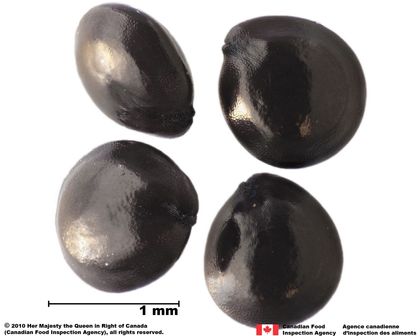 or dulldull:
or dulldull:
reflecting only a low proportion of incident light, with no apparent sheen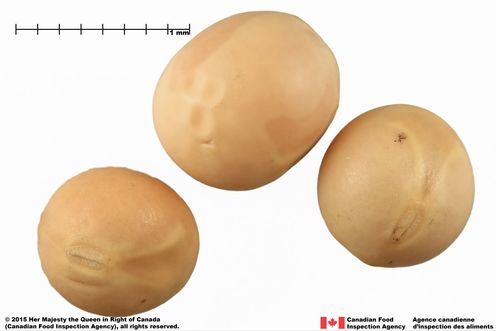 , usually fleshyfleshy:
, usually fleshyfleshy:
texture—fairly firm and dense, juicy or at least moist, and easily cut
, chartaceouschartaceous:
=papery, papyraceous
(Sclerophylax), glabrousglabrous:
without hairs
, rarely pubescentpubescent:
surface relief—bearing hairs
, smooth, rarely spinyspiny:
having slender, stiff, sharp projections oriented in the general plane of the structure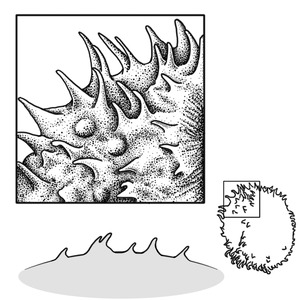 . Mesocarpmesocarp:
. Mesocarpmesocarp:
the middle layer of the pericarp, if divided into layers
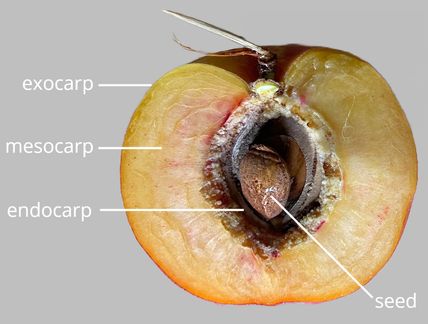 usually fleshyfleshy:
usually fleshyfleshy:
texture—fairly firm and dense, juicy or at least moist, and easily cut
(fibrous in Duckeodendron), covered by leatheryleathery:
texture—moderately thick, tough, and very pliable
, woodywoody:
texture—consisting mainly of indurate lignified tissues, characteristic of or resembling wood
, membranousmembranous:
texture—extremely thin, pliable, and fairly tough
or dry and brittle epicarpepicarp:
outer layer of fruit wall or pericarp, if divided into layers; note here used synonymously with exocarp .
.
Seed globoseglobose:
3D shape—more or less spherical to angularangular:
to angularangular:
2D shape—having sides that meet at acute or obtuse angles
, compressedcompressed:
flattened; in grasses, used to denote compression (not necessarily flattened) either laterally or dorsiventrally
or tereteterete:
approximately circular in cross section; width and thickness approximately equal
 , often flattened in berriesberry:
, often flattened in berriesberry:
an indehiscent, fleshy fruit with one or a few to many seeds. The flesh may be homogenous throughout. Or, if the outer part is hard, firm, or leathery, referred to as an hesperidium. Septa are present in some, and the seeds may be arillate or with a fleshy testa. , 0.3–35 mm long. Usually wingless, sometimes with thinthin:
, 0.3–35 mm long. Usually wingless, sometimes with thinthin:
having or being of relatively little depth
, broad wing encompassing seed. Elaiosomeelaiosome:
a lipid and protein-rich fleshy structure attached to some seeds and fruits, it attracts ants which then disperse the disseminule (e.g., caruncle in the Euphorbiaceae, the aril (outgrowth of the funiculus) in the Fabaceae)
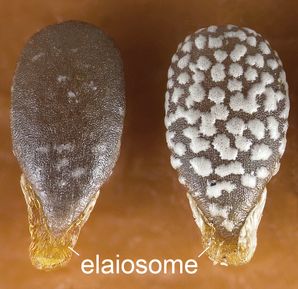 present in some species of Datura. Seed coat brown, black, yellow, dulldull:
present in some species of Datura. Seed coat brown, black, yellow, dulldull:
reflecting only a low proportion of incident light, with no apparent sheen , glabrousglabrous:
, glabrousglabrous:
without hairs
or pubescentpubescent:
surface relief—bearing hairs
with short, dense hairs, smooth or reticulatereticulate:
surface relief—netted, raised walls or concave grooves forming a net-like surface pattern with flat, concave, or convex interspaces , wartywarty:
, wartywarty:
surface relief—distinct, rounded projections that are large relative to the fruit size; tuberculate, verrucose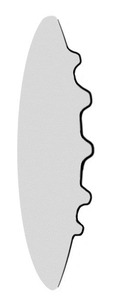 , pittedpitted:
, pittedpitted:
surface relief—surface with small depressions in which the areas between the hollows do not take on the appearance of a true reticular net , or punctatepunctate:
, or punctatepunctate:
surface relief—dotted with pits or with translucent, sunken glands or with colored dots, similar to pitted . Rapheraphe:
. Rapheraphe:
a ridge or seam on the seed coat, formed by the portion of the funiculus united to the ovule wall in longitudinally curved ovules
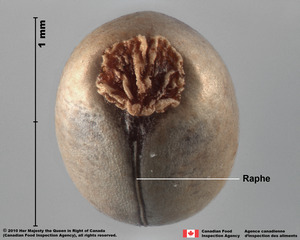 conspicuous as a black dorsaldorsal:
conspicuous as a black dorsaldorsal:
abaxial; the back of an organ; the side away from the axis (compare ventral)
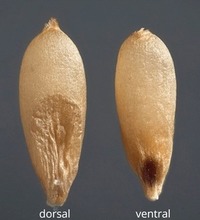 ridge (Coeloneurum, Espadaea, Goetzea, Henoonia). Hilumhilum:
ridge (Coeloneurum, Espadaea, Goetzea, Henoonia). Hilumhilum:
on seeds, the scar indicating where the funiculus was attached; on grass caryopses, the scar visible on the outer fruit surface revealing where the seed is attached on the inner fruit wall surface; or in Asteraceae cypselae, the scar visible on the outer fruit wall revealing where the fruit was attached to the receptacle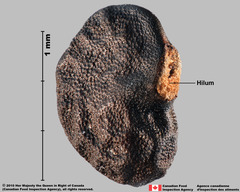 punctate or larger than punctatepunctate:
punctate or larger than punctatepunctate:
surface relief—dotted with pits or with translucent, sunken glands or with colored dots, similar to pitted .
.
Embryo well developed, usually one, two in (Coeloneurum, Espadaea, Goetzea, Henoonia), completely to partially filling seed coat, axileaxile:
on or of the axis
and centric or peripheralperipheral:
(of embryo) embryo is curved around the outer edge of the seed, near the seed coat
, linearlinear:
(shape) long, narrow, and uniform in width; (of embryo) embryo is straight and much longer than wide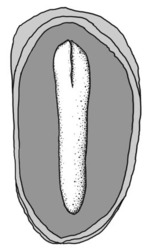 , foliatefoliate:
, foliatefoliate:
appearing leaf-like
, or miniature, usually straight or curvedcurved:
(of embryo) linear embryo is curved into an arch or horseshoe with the ends far apart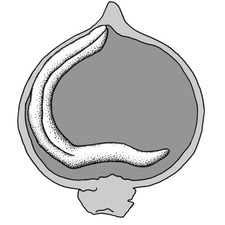 , curvedcurved:
, curvedcurved:
(of embryo) linear embryo is curved into an arch or horseshoe with the ends far apart to spiral in Nolana, or U-shaped (Duckeodendron).
to spiral in Nolana, or U-shaped (Duckeodendron).
Endosperm endosperm:
nutritive starch- and oil-containing tissue present in many seeds
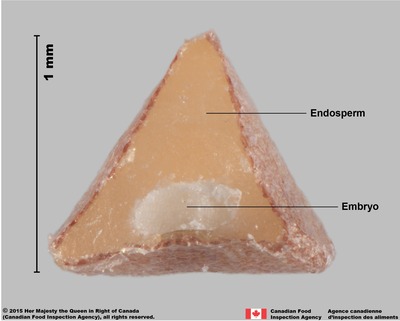 usually copious, scanty in Duckeodendron.
usually copious, scanty in Duckeodendron.
Solanaceae Source includes keys to Solanum species.
Noxious Weeds: USA Federal Noxious Weed List, Lycium ferocissimum Miers, terrestrial; Solanum torvum Swartz, terrestrial; Solanum viarum Dunal, terrestrial; Solanum tampicense Dunal, aquatic.
Federal Noxious Weed Disseminules of the US ID tool provides keys, descriptions, and images of these species.
| Fruit | |
| Type | berry, capsulecapsule: a dry, dehiscent fruit formed by two or more carpels  , drupedrupe: , drupedrupe:(indehiscent drupe) a fleshy, indehiscent fruit with one more hard pits enclosing seeds; (dehiscent drupe) a fruit with a dry or fibrous to fleshy or leathery outer husk that early to tardily breaks apart (or opens), exposing one or more nutlike pits enclosing the seeds  , schizocarpschizocarp: , schizocarpschizocarp:fruit formed from a single ovary, with fused carpels, with or without accessory tissue; splitting between locules to form distinct, indehiscent, usually one seeded segments; usually dry, rarely fleshy (compare mericarp)  , carcerulus , carcerulus |
| Size range | 3.5–100 mm long |
| Shape(s) | globose, ellipsoidellipsoid: 3D shape—elliptic , fusiformfusiform: spindle-shaped; broadest at the middle and tapering at both ends 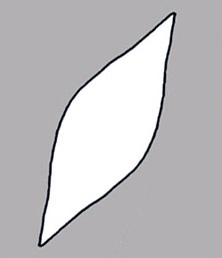 , ovoidovoid: , ovoidovoid:3D shape—ovate  , pyriform, obconicobconic: , pyriform, obconicobconic:2D shape—cone-shaped, with attachment at or near the narrow end , angular |
| Texture | mesocarp mesocarp: the middle layer of the pericarp, if divided into layers  usually fleshyfleshy: usually fleshyfleshy:texture—fairly firm and dense, juicy or at least moist, and easily cut , covered by leatheryleathery: texture—moderately thick, tough, and very pliable , woodywoody: texture—consisting mainly of indurate lignified tissues, characteristic of or resembling wood , membranousmembranous: texture—extremely thin, pliable, and fairly tough or dry and brittle epicarp |
| Surface relief | smooth, rarely spiny |
| Color(s) | brown, black, purple, blue, yellow, orange, red, purple, green, white, rarely spotted |
| Unique features | Usually many-seeded berriesberry: an indehiscent, fleshy fruit with one or a few to many seeds. The flesh may be homogenous throughout. Or, if the outer part is hard, firm, or leathery, referred to as an hesperidium. Septa are present in some, and the seeds may be arillate or with a fleshy testa.  or capsulescapsule: or capsulescapsule:a dry, dehiscent fruit formed by two or more carpels  , often brightly colored, with fleshyfleshy: , often brightly colored, with fleshyfleshy:texture—fairly firm and dense, juicy or at least moist, and easily cut , including spongyspongy: soft, light, discontinuous but cohesive, and somewhat resilient or pulpy mesocarpsmesocarp: the middle layer of the pericarp, if divided into layers  . . |
| Seed | |
| Size range | 0.3–35 mm long |
| Shape(s) | globose, discoiddiscoid: 3D shape—resembling a disc 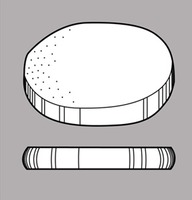 , circularcircular: , circularcircular:(of embryo) linear embryo is curved into an "O" shape 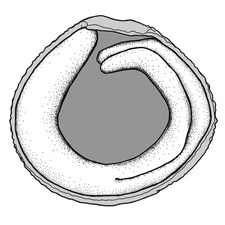 , ellipsoidellipsoid: , ellipsoidellipsoid:3D shape—elliptic , ovoidovoid: 3D shape—ovate  , lens-shapedlens-shaped: , lens-shapedlens-shaped:2D shape—round and flattened with two curved (convex) surfaces , reniformreniform: 2D or 3D shape—kidney-shaped  , angularangular: , angularangular:2D shape—having sides that meet at acute or obtuse angles , cuboidal, U-shaped (Duckeodendron) |
| Surface relief | smooth, reticulatereticulate: surface relief—netted, raised walls or concave grooves forming a net-like surface pattern with flat, concave, or convex interspaces  , wartywarty: , wartywarty:surface relief—distinct, rounded projections that are large relative to the fruit size; tuberculate, verrucose  , pittedpitted: , pittedpitted:surface relief—surface with small depressions in which the areas between the hollows do not take on the appearance of a true reticular net  , punctate , punctate |
| Color(s) | brown, black, yellow |
| Unique features | Usually brown or yellow seeds, often finely netted, pittedpitted: surface relief—surface with small depressions in which the areas between the hollows do not take on the appearance of a true reticular net  , or with regular depressions, flattened in berriesberry: , or with regular depressions, flattened in berriesberry:an indehiscent, fleshy fruit with one or a few to many seeds. The flesh may be homogenous throughout. Or, if the outer part is hard, firm, or leathery, referred to as an hesperidium. Septa are present in some, and the seeds may be arillate or with a fleshy testa.  or angularangular: or angularangular:2D shape—having sides that meet at acute or obtuse angles (often cuboidal) in capsulescapsule: a dry, dehiscent fruit formed by two or more carpels  , and with copious, fleshyfleshy: , and with copious, fleshyfleshy:texture—fairly firm and dense, juicy or at least moist, and easily cut endospermendosperm: nutritive starch- and oil-containing tissue present in many seeds  . HilaHilum: . HilaHilum:on seeds, the scar indicating where the funiculus was attached; on grass caryopses, the scar visible on the outer fruit surface revealing where the seed is attached on the inner fruit wall surface; or in Asteraceae cypselae, the scar visible on the outer fruit wall revealing where the fruit was attached to the receptacle  in flattened seeds marginalmarginal: in flattened seeds marginalmarginal:at, on, or close to the margin or border or occasionally in the notch. In angularangular: 2D shape—having sides that meet at acute or obtuse angles seeds, hilahilum: on seeds, the scar indicating where the funiculus was attached; on grass caryopses, the scar visible on the outer fruit surface revealing where the seed is attached on the inner fruit wall surface; or in Asteraceae cypselae, the scar visible on the outer fruit wall revealing where the fruit was attached to the receptacle  at one end. at one end. |
| Other | |
| Embryo | well developed, usually one, two in (Coeloneurum, Espadaea, Goetzea, Henoonia), completely to partially filling seed coat, axileaxile: on or of the axis and centric or peripheralperipheral: (of embryo) embryo is curved around the outer edge of the seed, near the seed coat , linearlinear: (shape) long, narrow, and uniform in width; (of embryo) embryo is straight and much longer than wide  , foliatefoliate: , foliatefoliate:appearing leaf-like , or miniature, usually straight or curvedcurved: (of embryo) linear embryo is curved into an arch or horseshoe with the ends far apart  , curvedcurved: , curvedcurved:(of embryo) linear embryo is curved into an arch or horseshoe with the ends far apart  to spiral in Nolana, or U-shaped (Duckeodendron) to spiral in Nolana, or U-shaped (Duckeodendron) |
| Nutritive tissuenutritive tissue: tissue within the seeds that nourishes the developing embryo; such as endosperm, perisperm, or chalazosperm in angiosperms; megagametophyte in gymnosperms |
endosperm endosperm: nutritive starch- and oil-containing tissue present in many seeds  usually copious, scanty in Duckeodendron usually copious, scanty in Duckeodendron |
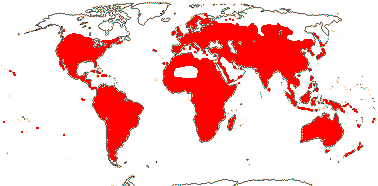
Distribution map courtesy of Angiosperm Phylogeny Website.
Chiarini and Bohs 2022; Kirkbride et al. 2006; Knapp et al. 2019; Kubitzki et al. 1990+; Mentz and de Oliveira 2004; Milliken et al. 2009+; Noxious Weed Regulations 2020; PBI Solanum Project 2023; USDA 1980; Takhtajan 2009; Zomlefer 1994
*The number of genera and species is based on Christenhusz and Byng 2016, which may differ from the number of genera in GRIN-Global.